Private Spaces and Oases – How to give a small backyard a big attitude
Dawn Dellasanta-Swann writer
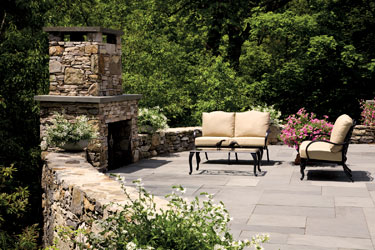 Sometimes it seems as if what one gains in convenience by living close to a city is proportionate to what’s lost in a backyard. Is “yard” a bit generous a term for the postage stamp-sized chunk of grass hidden behind the house? Do you long for a place to entertain friends and play ball with the kids but think it’s just not possible where you are? Instead of lamenting what’s lacking, start speaking the language of imaginative city dwellers from generations past. Think of secret London gardens hidden by wrought iron and hedgerow. Imagine the lush, loamy jewel-box gardens of Savannah and Charleston. Begin a love affair with your backyard. Gregory Lombardi of Lombardi Design in Cambridge says that a tiny backyard provides the “canvas” for those intimate scenes that people really want. With a small backyard comes the opportunity to play, to stick your fingers into the earth, and to find your own perfect oasis.
Sometimes it seems as if what one gains in convenience by living close to a city is proportionate to what’s lost in a backyard. Is “yard” a bit generous a term for the postage stamp-sized chunk of grass hidden behind the house? Do you long for a place to entertain friends and play ball with the kids but think it’s just not possible where you are? Instead of lamenting what’s lacking, start speaking the language of imaginative city dwellers from generations past. Think of secret London gardens hidden by wrought iron and hedgerow. Imagine the lush, loamy jewel-box gardens of Savannah and Charleston. Begin a love affair with your backyard. Gregory Lombardi of Lombardi Design in Cambridge says that a tiny backyard provides the “canvas” for those intimate scenes that people really want. With a small backyard comes the opportunity to play, to stick your fingers into the earth, and to find your own perfect oasis.
Plot Your Thought
Just like in any major undertaking, the planning stage should get top billing in a small backyard makeover. Lombardi urges homeowners to fight the impulse to clear cut, mow, and level a piece of property in order to start fresh. In other words, think twice before chopping down the copse of hundred year-old oaks or tilling over the plush carpet of moss. Each unique property comes with its own features and limitations. That oak grove and that brilliant moss make the perfect backdrop for a minimalist, Zen-like oasis. That’s not to say that editing or removing things isn’t important – but let the editing come from the design plan. Create an idea, develop the idea, test it out in theory, and then act on it. Dan Gordon of Dan K. Gordon Associates says that while the Wellesley area isn’t Charleston or Savannah, a lot of the same small garden principles apply. With a concept in place, establish a clear definition of space. Decide how the area will be used, who will use it, and what feelings you want to experience when you step out into your backyard.
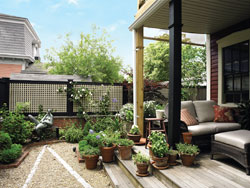 Ask the Experts
Ask the Experts
Changing the look and atmosphere of a yard isn’t as simple as slapping on a fresh coat of paint and switching the pillows. When dealing with living, growing things that take seasons or even years to come to maturity, one must be careful to plan correctly. A consultation with a landscape design professional can be invaluable in order to obtain a fresh perspective from an individual with specialized skills and no emotional investment in the existing yard. Heather Lashbrook Jones of A Blade of Grass in Wayland says an expert can pinpoint potential pitfalls that many homeowners might not see like cold pockets, or too much sun or too much shade. Lombardi, educated in fine arts, sees the yard as a painter’s canvas. “Large trees are amazing scale pieces,” he says. “Sometimes you have to educate people so they don’t destroy the patina.”
Find Your Dream
Think of your backyard as an extension of the house. You can design a complementary riff of your interior decorating style, deliberately contradict it, or fall somewhere in between. What’s important is that inside and out should harmonize. New Englanders have a tendency to ring the house with traditional molded evergreens and call it a day. Lombardi wants us to let the influences of warmer climates move us to shed the shrubs and bring the inside out. Start by finding photos of yards and gardens that move you and paste them in a dream book. Gordon says to list the various functions the yard will serve as well. If you have kids, think about how many plastic toys you will need to accommodate over the next decade or so and plan storage space accordingly. If outdoor cooking and entertaining strike your fancy, explore the vast options available for today’s outdoor chefs. Live near traffic? Consider adding a water feature to drown out the noise.
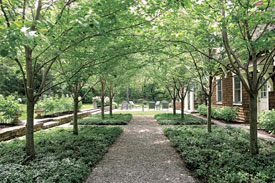 Layers of Design
Layers of Design
Lombardi calls the small backyard an experiment in contrasts where elaboration is sometimes restricted yet it can offer more opportunity for creative play than larger spaces. Keep in mind the way a bold wallpaper pattern works in a tiny powder room, or approach landscape design the way a writer would a novel or a filmmaker a movie: don’t waste film, don’t waste words, and don’t waste yard space. Use every inch to express your vision. Start from the outside and work your way in, one layer at a time.
Layer 1 Privacy and Structure
Robert Frost once wrote that, “Good fences make good neighbors.” Donna Pelletier from family-owned Reliable Fence Metrowest says that the best form of privacy comes from the traditional privacy fence, usually made from six-foot stockade in cedar, which, if left natural, ages to silvery gray, or composite PVC. Both options can be further customized with color and decorative tops like square lattice or spikes. Pelletier says that English lattice fences with arbors for roses and ivy capitalize on vertical space while providing a natural screen from neighbors. Evergreens like arborvitae of the cypress family make excellent privacy walls too. Play around with different combinations of evergreen and stockade, and, if you have mature trees in the yard, factor those into the privacy layer as well.
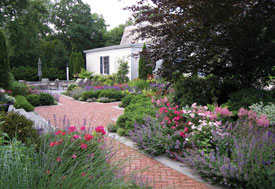 Layer 2 Beds
Layer 2 Beds
Jones says to build border beds beside the fence of about four to six feet. Imagine a gentle, tiered effect using midsized hydrangeas mixed with annuals like impatiens, which can be easily replaced or added to. Perennials like cone flowers can make a nice border but remember that at some point they are going to spread and need replanting. Jones advises planting in odd groups of three or five plants of each type for smaller yards. Keep the visual interest up by mixing groups of like-sized annuals, but try not to go crazy and buy one of everything that looks nice or the desired effect will be lost in chaos. Remember to plant for seasonal interest and include plants like ornamental grasses that last into the fall and evergreens or shrubs with interesting “architectural” features for the winter.
Layer 3 What’s Underfoot
A backyard isn’t just grass. Thinking in terms of outdoor living, it’s wise to change the “flooring” of your outdoor living space according to the needs of the area. Patio or terrace materials can be just as personalized as interior floors, ranging from wooden decking to bluestone to concrete. It’s okay to match or mix materials here as well. Thinking in terms of outdoor rooms, the “dining area” might be a teak deck outside a set of French doors while the “kitchen area” is made up of brick. Keep a carpet of lawn toward the back or side to beckon bare feet.
 Sue Donahue of Walpole Woodworkers suggests using attached and freestanding pergolas to define a light and airy room on the patio or in the garden. Create an instant outdoor kitchen or entertainment area with one of these architectural structures that can easily accommodate furniture and full-size grills. Motor-driven or hand-operated retractable pergola canopies give you and your guests the opportunity to relax and enjoy the fresh air regardless of whether or not the sun is blazing or a light rain is falling.
Sue Donahue of Walpole Woodworkers suggests using attached and freestanding pergolas to define a light and airy room on the patio or in the garden. Create an instant outdoor kitchen or entertainment area with one of these architectural structures that can easily accommodate furniture and full-size grills. Motor-driven or hand-operated retractable pergola canopies give you and your guests the opportunity to relax and enjoy the fresh air regardless of whether or not the sun is blazing or a light rain is falling.
Layer 4 Focal Points, Features, and Furniture
Think of the way a mountain catches your eye in the distance or a bold painting hanging on a wall. Focal points serve as a place for the eye to rest. A combination of form, function, and an expression of your personality, focal points include built-in elements like fire pits and water features. Jones says that water features combine beauty and serenity with purpose because their “nice trickling sound covers the sound of traffic going by.” Fire pits offer a place for intimate conversation, marshmallow roasting, and provide a special ambiance. Think about putting in a low wall around a fire pit for additional casual seating. Bonsai, statues, and freestanding arbors can also be focal points. So can a beautiful, centrally-located ornamental tree like a curly-branched hazelnut.
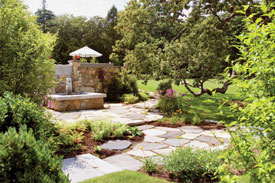 Layer 5 Red Herrings
Layer 5 Red Herrings
The fifth layer is all about fun. Incorporate little bits of whimsy or personal treasures for viewers to come upon and relish. Make people say, “Wow, look at that,” says Lombardi. “You have to pay attention to the details. There is joy in surprise.” Think about a Mississippi Bottle Tree, a column, or sculpture. Jones says that container planting is the perfect way to spice up the oasis. Let your creativity flow and use containers for bright splashes of color and seasonal arrangements. In the springtime, plant tulips and pastel colored flowers. In fall, think of grasses and mums and in winter, clipped boxwoods and berries. As for summertime, let your inner artist go wild at the nursery. Anything goes. Consider planting those beautiful flowers that might not work in the border beds in containers that can be easily moved. Jones also recommends replacing the pillows on outdoor furniture each season to keep the look fresh and crisp.
Stop and Smell the Roses
The experts say to follow your instincts and create the backyard oasis that you really want. However, if that means wiping out the existing landscape and installing a lawn, then they might try to talk you out of it. Lombardi finds it interesting that while the United States has a great gardening tradition, it’s not quite as gender-neutral as the one that exists throughout the United Kingdom. “In the US, men tend to confuse gardening with maintenance. Women are allowed to talk about gardening and to like pretty flowers. Lots of men think of a golf course with trees.”
People are busy, and gardens require maintenance, but Lombardi reminds us that the small backyard garden can afford even the busiest professionals a chance to take a few moments to slow down and connect with nature. ![]()
© 2011 Elm Bank Media | Beth Furman, Publisher | Beth@ElmBankMedia.com

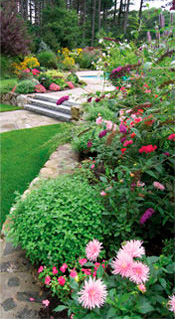

recent comments